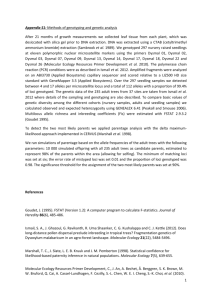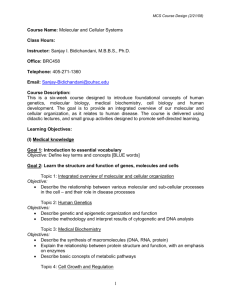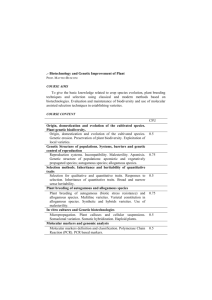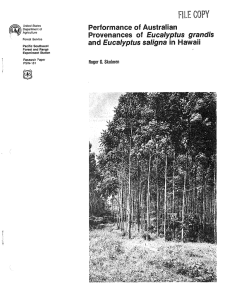MEC_5601_sm_Supporting_Information
advertisement
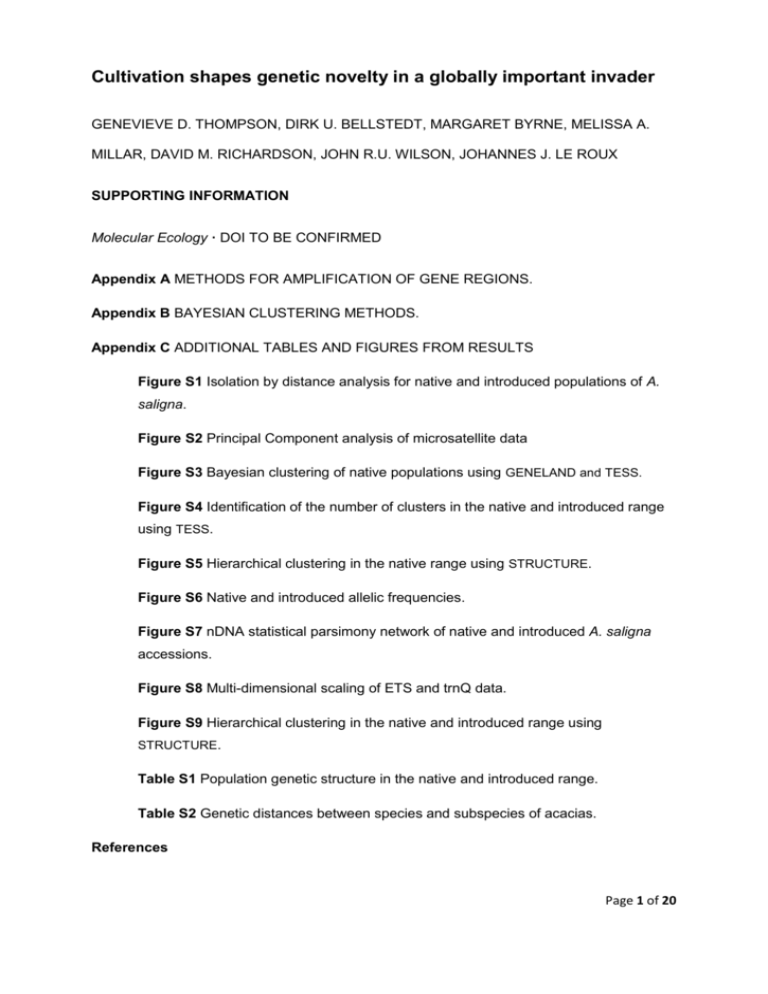
Cultivation shapes genetic novelty in a globally important invader GENEVIEVE D. THOMPSON, DIRK U. BELLSTEDT, MARGARET BYRNE, MELISSA A. MILLAR, DAVID M. RICHARDSON, JOHN R.U. WILSON, JOHANNES J. LE ROUX SUPPORTING INFORMATION Molecular Ecology · DOI TO BE CONFIRMED Appendix A METHODS FOR AMPLIFICATION OF GENE REGIONS. Appendix B BAYESIAN CLUSTERING METHODS. Appendix C ADDITIONAL TABLES AND FIGURES FROM RESULTS Figure S1 Isolation by distance analysis for native and introduced populations of A. saligna. Figure S2 Principal Component analysis of microsatellite data Figure S3 Bayesian clustering of native populations using GENELAND and TESS. Figure S4 Identification of the number of clusters in the native and introduced range using TESS. Figure S5 Hierarchical clustering in the native range using STRUCTURE. Figure S6 Native and introduced allelic frequencies. Figure S7 nDNA statistical parsimony network of native and introduced A. saligna accessions. Figure S8 Multi-dimensional scaling of ETS and trnQ data. Figure S9 Hierarchical clustering in the native and introduced range using STRUCTURE. Table S1 Population genetic structure in the native and introduced range. Table S2 Genetic distances between species and subspecies of acacias. References Page 1 of 20 Thompson et al. (2012) Cultivation shapes genetic novelty in a globally important invader. Molecular Ecology Appendix A AMPLIFICATION OF NUCLEAR AND CHLOROPLAST GENE REGIONS The nuclear ETS region was amplified using the primers described in Brown et al. (2008), and the PCR setup and conditions described in Le Roux et al. (2011). Accessions that did not produce clean sequences were cloned using the PGEM® -T Easy Vector System (Promega, Anatech, Johannesburg, South Africa), and had a number of inserts sequenced. The chloroplast region (trnQ - 5’rps16) was amplified using the primers described in Shaw et al. (2007), and the following PCR conditions: each 50 µL reaction contained approximately 30 ng of genomic DNA, 200 µM of each dNTP (AB gene; Southern Cross Biotechnologies, Cape Town, South Africa), 25 pmol of each primer, 0.5 U Taq DNA polymerase (SuperTherm JMR-801; Southern Cross Biotechnologies), 10 X PCR reaction buffer, 3 mM MgCl2. The reaction was held at 95 °C for 5 minutes prior to the addition of Taq. Thermocycling consisted of initial denaturation at 95 °C for 2 min, 35 cycles of 95 °C for 15 s, 56 °C for 30 s, 72 °C for 10 s; and a final extension of 72 °C for 10 min. Amplified DNA fragments were purified using the QIAquick PCR Purification kit (Qiagen, Cape Town, South Africa, Southern Cross Biotechnologies), sequenced using the ABI PRISM BigDye Terminator Cycle Sequencing Ready Reaction kit (forward only) and an automated ABI PRISM 377XL DNA sequencer (PE Applied Biosystems, Foster City, CA, USA). Page 2 of 20 Thompson et al. (2012) Cultivation shapes genetic novelty in a globally important invader. Molecular Ecology Appendix B BAYESIAN CLUSTERING METHODS First we used a hierarchical clustering approach (Le Roux et al. 2010) implemented in STRUCTURE (Falush et al. 2007) and the ΔK method of Evanno et al. (2005) to determine all levels of population structure in the native range (Knative). This approach was repeated for the native and invasive range (Kcombined). We followed the methods of Rollins et al. (2009), simulating K values from one upwards until either K exceeded the total number of populations, or the number of individuals per population was insufficient to allow for further analyses of population structure. Individuals that could not be assigned with more than 60% of their scored loci to a particular group were not included in subsequent analyses. Furthermore, individuals within a single population that were assigned to a genetic group outside of their population of origin were separated into their respective genetic groups for the next level of the analysis. Second, we conducted an analysis using the spatial model in GENELAND (Guillot et al. 2005), implemented in R (Ihaka & Gentleman 1996, R Development Core Team 2004). GENELAND produces results that are robust when fine scale population structure is present (see Guillot 2008). GENELAND uses spatial co-ordinates as artificial centres around which the genetic groups are clustered. In this way it is able to incorporate spatial information without actually using the physical location of the sampled populations. We conducted ten independent runs using correlated allele frequencies, and 1 million iterations of the Markov chain Monte Carlo procedure, saving every 1 000th iteration. Third, we determined the optimal number of K clusters for A. saligna using TESS (Chen et al. 2007) so we could compare our results to Millar et al. (2011). We used spatial information when determining Knative, but not for Kcombined. We followed the methods of Millar et al. (2011) for all parameters, except that we used an admixture model for the reason outlined in François and Durand (2010). For each value of Kmax, we computed the Deviance Information Criterion (DIC), and averaged the estimated admixture coefficients over 20 % of the runs with the lowest DIC values plotted against K for all runs. We then selected the minimum value of Page 3 of 20 Thompson et al. (2012) Cultivation shapes genetic novelty in a globally important invader. Molecular Ecology K for which DICK was not significantly different from the mean of all values of DIC greater than K based on a one-sample t-test. Page 4 of 20 Thompson et al. (2012) Cultivation shapes genetic novelty in a globally important invader. Molecular Ecology Appendix C ADDITIONAL RESULTS (TABLES AND FIGURES) Figure S1 Relationship between genetic and geographic distance for Acacia saligna populations in the native range in Western Australia (A) and the introduced range in South Africa (B) based on 10 nuclear microsatellite loci. Population pairwise genetic (FST calculated in ARLEQUIN) and geographic (Euclidean) distance was correlated using a Mantel test and the online “isolation by distance” service (http://ibdws.sdsu.edu/~ibdws). Page 5 of 20 Thompson et al. (2012) Cultivation shapes genetic novelty in a globally important invader. Molecular Ecology Figure S2 Genetic correlation between native lineages of Acacia saligna (circles, diamonds, triangles) and introduced populations from South Africa (crosses) using a principle co-ordinate analysis of microsatellite data. Native lineages include A. saligna subspecies ‘lindleyi’ (Group 1), and subspecies ‘stolonifera’ and subspecies ‘saligna’ (Group 2). Group 3 comprised of invasive South African populations and two native populations (Tua and Bus), and clustered separately from the two major native Groups. Co-ordinate 1 explained 34.6% of the variation, and Co-ordinate 2 explained 22.6% of the variation. Page 6 of 20 Thompson et al. (2012) Cultivation shapes genetic novelty in a globally important invader. Molecular Ecology Figure S3 Bayesian clustering of native populations of Acacia saligna based on 10 nuclear microsatellite loci in the software GENELAND and TESS Page 7 of 20 Thompson et al. (2012) Cultivation shapes genetic novelty in a globally important invader. Molecular Ecology Figure S4 Identification of the optimal number of clusters in the native range (A), as well as the native and introduced range (B) of Acacia saligna. The data sets contain a total of A) 202 and B) 365 individuals for 10 diploid, nuclear microsatellite loci. For each region (native and introduced), we performed 1000 independent runs of 10 000 sweeps using an admixture parameter α = 0.6 in TESS. We kept 20% of runs that had the lowest DIC or lnP(D|K) values, averaged their outputs per K value, and plotted these averages against K. Page 8 of 20 Thompson et al. (2012) Cultivation shapes genetic novelty in a globally important invader. Molecular Ecology Figure S5 – see legend on next page. Page 9 of 20 Thompson et al. (2012) Cultivation shapes genetic novelty in a globally important invader. Molecular Ecology Figure S5 Identification of the optimal number of clusters (Knative) for Acacia saligna in the native range in Western Australia using hierarchical Bayesian clustering in the software STRUCTURE. The data set contains a total of 14 populations containing 202 individuals genotyped at 10 nuclear microsatellite loci that were clustered at 3 hierarchical levels: Level 1 (A), Level 2 (B, C, D) and Level 3 (E, F, G). The estimated proportional membership is represented by bar plots, where each bar is an individual that is divided into K-coloured segments representing the proportional membership of each individual’s genome (qi) to a particular K cluster. The optimal K for each level of clustering was identified using the ΔK method (Evanno et al. 2005) and is graphed with each plot. Sampling site labels are indicated below each plot. Page 10 of 20 Thompson et al. (2012) Cultivation shapes genetic novelty in a globally important invader. Molecular Ecology Figure S6 Distribution of microsatellite allelic frequencies that differed by at least 10 %between the native and introduced ranges of Acacia saligna. Loci and alleles presented were selected to display the maximum variation between the native and introduced range. Page 11 of 20 Thompson et al. (2012) Cultivation shapes genetic novelty in a globally important invader. Molecular Ecology Figure S7- see legend on next page. Page 12 of 20 Thompson et al. (2012) Cultivation shapes genetic novelty in a globally important invader. Molecular Ecology Figure S7 Spatial distribution of sequence variation (external transcribed spacer region) for Acacia saligna accessions in (A) native Western Australia and (B) introduced South African populations. Statistical parsimony networks were constructed in TCS for Acacia saligna accessions in (C and D), where each circle represents a sampled haplotype (size proportional to frequency) and each link between haplotypes indicates one mutational event. The pie slices of a circle indicate the proportion of localities at which that haplotype was collected. Angle of bifurcation and length of link between haplotypes have no significance. Number of haplotypes (NH), haplotype diversity (h) and nucleotide diversity (p) are presented in bottom left corner for Western Australia (A) and South Africa (B). Page 13 of 20 Thompson et al. (2012) Cultivation shapes genetic novelty in a globally important invader. Molecular Ecology Figure S8 Separation of native and introduced individuals of Acacia saligna based on pairwise genetic distances for (A) cpDNA, the trnQ-5’rps16 region, and (B) nDNA, the ETS region. Genetic distances were translated into proximity co-ordinates using a nonmetric multidimensional scaling analysis. Page 14 of 20 Thompson et al. (2012) Cultivation shapes genetic novelty in a globally important invader. Molecular Ecology Figure S9- see legend on next page. Page 15 of 20 Thompson et al. (2012) Cultivation shapes genetic novelty in a globally important invader. Molecular Ecology Figure S9 Identification of the optimal number of clusters (K) for Acacia saligna in the native (Western Australia) and introduced (South Africa) range using hierarchical Bayesian clustering in the software STRUCTURE. The data sets contain a total of 21 populations containing 365 individuals genotyped at 10 nuclear microsatellite loci and clustered at 2 hierarchical levels: Level 1 (A) and Level 2 (B, C). The estimated proportional membership is represented by bar plots, where each bar is an individual that is divided into K-coloured segments representing the proportional membership of each individual’s genome (qi) to a particular K cluster. The optimal K for each level of clustering was identified using the ΔK method (Evanno et al. 2005) and is graphed with each plot. Sampling sites are indicated below each plot. Page 16 of 20 Thompson et al. (2012) Cultivation shapes genetic novelty in a globally important invader. Molecular Ecology Table S1 Population pairwise genetic structure for the native (Western Australia) and introduced (South Africa) range of Acacia saligna. Population pairwise FST values were calculated in ARLEQUIN using genotypic data generated from ten nuclear microsatellite loci Western Australia Parkeyerring Ravensthorpe Wellesley Busselton Tuart Forest Dinninup Wanneroo Leshnault Inlet Mount Ney Preston Muntagin Tweed River Wickepin Boyatup Hill PAR 0.004 0.149 0.138 0.193 0.005 0.281 0.355 0.296 0.239 0.180 0.323 0.174 0.253 RAV 0.226 0.253 0.343 0.026 0.347 0.433 0.370 0.310 0.182 0.374 0.190 0.319 WEL 0.167 0.273 0.150 0.348 0.258 0.432 0.199 0.216 0.362 0.221 0.336 BUS 0.007 0.197 0.244 0.392 0.310 0.275 0.304 0.219 0.298 0.212 TUA 0.224 0.231 0.504 0.275 0.360 0.374 0.172 0.342 0.246 DIN 0.333 0.288 0.283 0.213 0.130 0.340 0.119 0.256 WAN LEI MTN PRE MUN TWR WIC 0.386 0.307 0.258 0.419 0.164 0.412 0.189 0.506 0.085 0.335 0.418 0.318 0.399 0.420 0.388 0.296 0.359 0.144 0.219 0.302 0.202 0.248 0.426 0.020 0.355 0.423 0.219 0.335 South Africa CIN EBE BRE PA SED JBAY Cinsta Ebenhaezer 0.130 Breede River 0.172 0.036 Port Alfred 0.237 0.130 0.083 Sedgefield 0.086 0.034 0.035 0.115 Jeffreys Bay 0.195 0.063 0.045 0.132 0.073 Albertinia 0.106 0.122 0.174 0.268 0.086 0.204 Note: Bold values indicate highest and lowest FST values Page 17 of 20 Thompson et al. (2012) Cultivation shapes genetic novelty in a globally important invader. Molecular Ecology Table S2 Pairwise comparisons of nuclear genetic distances (external transcribed spacer) between species and subspecies within the Acacia genus. Pairwise comparisons Species - species A. rostellifera1 vs. A. saligna subspecies ‘lindleyi’ A. rostellifera1 vs. introduced A. saligna (South African) Subspecies - subspecies A. longifolia subspecies longifolia2 vs. subspecies sophorae3 A. saligna subspecies ‘lindleyi’ vs. subspecies ‘saligna’ A. saligna subspecies ‘lindleyi’ vs. subspecies ‘stolonifera’ A. saligna subspecies ‘saligna’ vs. subspecies ‘stolonifera’ Native clade - Introduced clade A. saligna subspecies ‘stolonifera’ vs. introduced A. saligna (South Africa) A. saligna subspecies ‘lindleyi’ vs. introduced A. saligna (South Africa) A. saligna subspecies ‘saligna’ vs. introduced A. saligna (South Africa) GenBank numbers: Genetic distance 0.091 0.161 0.003 0.016 0.012 0.021 0.085 0.061 0.089 1 JF420272 2 HM007639.1 3 HM007647 Page 18 of 20 Thompson et al. (2012) Cultivation shapes genetic novelty in a globally important invader. Molecular Ecology References Brown GK, Murphy DJ, Miller JT, Pauline YL. (2008) Acacia s.s. and its relationship among tropical legumes, tribe Ingeae (Leguminosae: Mimosoideae). Systematic Botany, 33, 739-751. Chen C, Durand E, Forbes F, François O. (2007) Bayesian clustering algorithms ascertaining spatial population structure: a new computer program and a comparison study. Molecular Ecology Notes, 7, 747-756. Evanno G, Regnaut S, Goudet J. (2005) Detecting the number of clusters of individuals using the software structure: A simulation study. Molecular Ecology, 14, 2611-2620. Falush D, Stephens M, Pritchard JK. (2007) Inference of population structure using multilocus genotype data: Dominant markers and null alleles. Molecular Ecology Notes, 7, 574-578. François O, Durand E. (2010) Spatially explicit Bayesian clustering models in population genetics. Molecular Ecology Resources, 10, 773-784. Guillot G, Estoup A, Mortier F, Cosson JF. (2005) A spatial statistical model for landscape genetics. Genetics, 170, 1261-1280. Guillot G. (2008) Inference of structure in subdivided populations at low levels of genetic differentiation - the correlated allele frequencies model revisited. Bioinformatics, 24, 222228. Ihaka R, Gentleman R. (1996) R: A language for data analysis and graphics. Journal of Computational and Graphical Statistics, 5, 299-314. Le Roux JJ, Brown GK, Byrne M, Ndlovu J, Richardson DM, Thompson GD, Wilson JRU. (2011) Phylogeographic consequences of different introduction histories of invasive Australian Acacia species and Paraserianthes lophantha (Fabaceae) in South Africa. Diversity and Distributions, 17, 861-871. Le Roux JJ, Wieczorek AM, Tran CT, Vorsino AE. (2010) Disentangling the dynamics of invasive fireweed (Senecio madagascariensis Poir. species complex) in the Hawaiian Islands. Biological Invasions, 1-14. Page 19 of 20 Thompson et al. (2012) Cultivation shapes genetic novelty in a globally important invader. Molecular Ecology Millar MA, Byrne M, O’Sullivan W. (2011) Defining entities in the Acacia saligna (Fabaceae) species complex using a population genetics approach. Australian Journal of Botany, 59, 137-148. R Development Core Team. (2004) R : A language and environment for statistical computing. ISBN 3–900051–00–3, http://www.Rproject.org. Rollins LA, Woolnough AP, Wilton AN, Sinclair R, Sherwin WB. (2009) Invasive species can’t cover their tracks: using microsatellites to assist management of starling (Sturnus vulgaris) populations in Western Australia. Molecular Ecology, 18, 1560-1573. Shaw J, Lickey EB, Schilling EE, Small RL. (2007) Comparisons of whole chloroplast genome sequences to choose noncoding regions for phylogenetic studies in angiosperms: the tortoise and the hare III. American Journal of Botany, 94, 275-288. Page 20 of 20
